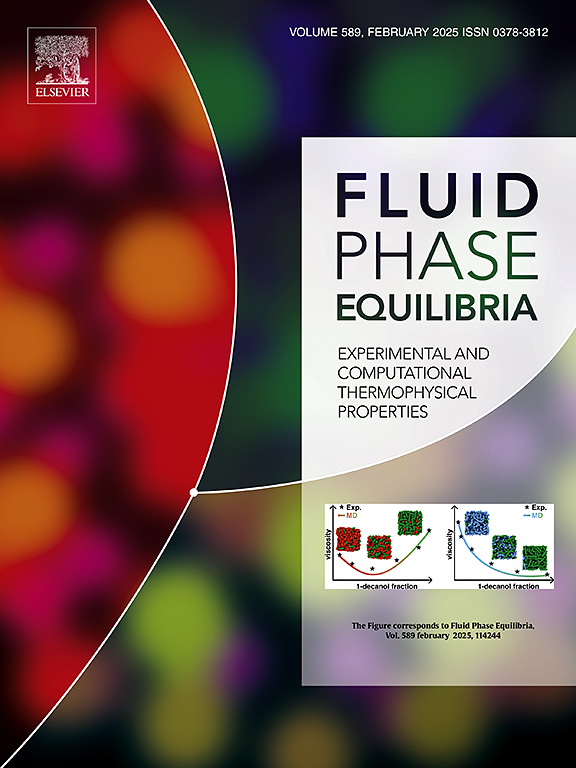MgCl2和压力对水+乙二醇体系中水分离汽液平衡的影响
IF 2.7
3区 工程技术
Q3 CHEMISTRY, PHYSICAL
引用次数: 0
摘要
在以乙二醇(EG)为溶剂的醇-氨法制备无水氯化镁的过程中,水+ EG +氯化镁(MgCl2)体系的脱水过程至关重要。因此,本文分析了在水+乙二醇体系中,MgCl2和压力对水分离汽液平衡的影响。水+ EG + MgCl2体系的等压汽液平衡(VLE)数据在101.3 kPa下测量,MgCl2质量分数分别为0、0.05、0.07和0.10。结果表明,MgCl2的加入提高了水+ EG体系的相平衡温度,降低了水相对于EG的相对挥发性。此外,在MgCl2质量分数为0.10时,测量了水+ EG + MgCl2体系在71.3、41.3和11.3 kPa时的VLE数据。通过降低系统压力,有效降低了平衡温度,显著提高了相对挥发性。本工作得到的实验数据在范内斯法热力学测试中是一致的。采用NRTL模型对实验数据进行关联。温度(T)和气相摩尔分数(y1)的实测值与计算值的均方根偏差分别小于0.53 K和0.006。NRTL模型的预测结果与实验数据吻合较好。本文章由计算机程序翻译,如有差异,请以英文原文为准。
Effect of MgCl2 and pressure on vapor-liquid equilibrium in separation of water in water + ethylene glycol system
In the process of preparing anhydrous magnesium chloride by the alcohol-ammonia method using ethylene glycol (EG) as the solvent, the dehydration process of the water + EG + magnesium chloride (MgCl2) system is crucial. Therefore, this work analyzed the effect of MgCl2 and pressure on vapor-liquid equilibrium in separation of water in water + ethylene glycol system. The isobaric vapor-liquid equilibrium (VLE) data for the water + EG + MgCl2 system were measured at 101.3 kPa with MgCl2 mass fractions of 0, 0.05, 0.07, and 0.10. It was found that the addition of MgCl2 raised the phase equilibrium temperature of the water + EG system and decreased the relative volatility of water relative to EG. Additionally, the VLE data for the water + EG + MgCl2 system at 71.3, 41.3 and 11.3 kPa were measured with the MgCl2 mass fraction of 0.10. The equilibrium temperature was effectively lowered, and the relative volatility was significantly increased by reducing the system pressure. The experimental data obtained in this work was consistent in thermodynamics test through Van Ness method. Moreover, the NRTL model was used to correlate experimental data. The root - mean - square deviations between the measured and calculated values of temperature (T) and vapor phase mole fraction (y1) were less than 0.53 K and 0.006 respectively. The NRTL model prediction with the regressed parameters was found in agreement with the experimental data.
求助全文
通过发布文献求助,成功后即可免费获取论文全文。
去求助
来源期刊

Fluid Phase Equilibria
工程技术-工程:化工
CiteScore
5.30
自引率
15.40%
发文量
223
审稿时长
53 days
期刊介绍:
Fluid Phase Equilibria publishes high-quality papers dealing with experimental, theoretical, and applied research related to equilibrium and transport properties of fluids, solids, and interfaces. Subjects of interest include physical/phase and chemical equilibria; equilibrium and nonequilibrium thermophysical properties; fundamental thermodynamic relations; and stability. The systems central to the journal include pure substances and mixtures of organic and inorganic materials, including polymers, biochemicals, and surfactants with sufficient characterization of composition and purity for the results to be reproduced. Alloys are of interest only when thermodynamic studies are included, purely material studies will not be considered. In all cases, authors are expected to provide physical or chemical interpretations of the results.
Experimental research can include measurements under all conditions of temperature, pressure, and composition, including critical and supercritical. Measurements are to be associated with systems and conditions of fundamental or applied interest, and may not be only a collection of routine data, such as physical property or solubility measurements at limited pressures and temperatures close to ambient, or surfactant studies focussed strictly on micellisation or micelle structure. Papers reporting common data must be accompanied by new physical insights and/or contemporary or new theory or techniques.
 求助内容:
求助内容: 应助结果提醒方式:
应助结果提醒方式:


